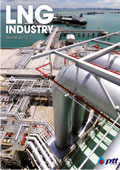Editorial comment
LNG Industry, along with a number of our sister publications, recently attended the Gastech Conference & Exhibition in London. Throughout the course of the week, I had an opportunity to visit a number of our readers for the first time and get their take on the future of the industry.
Register for free »
Get started now for absolutely FREE, no credit card required.
Back in March 2011, when Amsterdam played host to the previous Gastech show, the imminent prospect of floating LNG projects dominated discussions. FLNG was, as aptly described during this year’s conference wrap-up session, the ‘baby waiting to be born’. Now that the baby is taking its first steps, with Shell’s Prelude project in the Browse Basin offshore Western Australia leading the way, talk seems to have shifted to ‘what’s next?’
Closing proceedings at this year’s conference, Bill Sember, ABS Vice President of Global Gas Development, suggested that once the Prelude FLNG unit has proven itself, along with a number of other offshore projects in Malaysia and Indonesia, we will start to witness a flurry of new FLNG projects globally. This seems inevitable, as stranded natural gas fields are exploited to keep up with global demand for natural gas (recent IEA forecasts predict that global gas use will rise by over 50% from 2010 levels by 2035). And, besides, isn’t it always the case that those around you start to become a little broody once they realise how ‘cute’ (in this case, read: ‘cost and time saving’) your newborn is?
However, Sember’s closing remarks also pointed towards another use of LNG that seems to be gathering momentum: “Just as in FLNG, we are going to see a seismic shift in the use of LNG as fuel.” As emissions regulations continue to play a central role in the world energy mix, it seems evident that increasingly more companies are exploring the possibility of LNG shipping and bunkering applications.
In a recent move in this direction, DNV and nine key members of the Australian maritime, port and energy sectors have organised a joint industry project (JIP) for a four month study into the adoption of LNG fuelled vessels in Australia. The study will cover infrastructure and regulatory requirements, as well as the potential benefits and risks facing those considering the adoption of LNG fuelled vessels. The JIP will report back on its findings by the end of this year.
The results of studies such as this are likely to go some way to determining whether Sember is correct in his prediction that we are on the cusp of the next big development in the industry.
Sticking with the theme of looking to the future, our final issue of the year includes a brief update on a selection of current and future projects from around the global LNG industry (starting on p. 63).
As for the question of ‘what’s next’ for LNG Industry? Well, we’re moving with the golden age and going bi-monthly! As of January 2013, you will have six issues of LNG Industry to look forward to, each providing in-depth technical articles, expert analysis and regional reports from around the industry. As always, we welcome contributions from our readers. So, if you have a story to tell, please feel free to drop me a line. Alternatively, you can also join in the discussion at our new LinkedIn Group!


